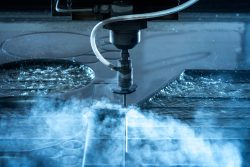How Accurate Is Waterjet Cutting?
April 28, 2023 10:28 pm Leave your thoughts How Accurate Is Waterjet Cutting?
How Accurate Is Waterjet Cutting?
Waterjet cutting is an excellent way to cut a variety of materials. Its accuracy is unparalleled, especially compared to other cutting methods like plasma and laser. Accuracy is important because it ensures that a part will be manufactured to a high level of quality and durability. This can mean that it will last longer and be more cost-effective for the company.
Accuracy
When you need to cut a piece of material, accuracy is an important factor. Waterjet cutting delivers a high level of precision, especially for complex materials. Waterjet cutters can cut a variety of materials, including soft foam, fiber-reinforced rubber and very hard rubber. They also work well for cutting steel. The amount of abrasive mixed in the waterstream has a major impact on cutting accuracy. This abrasive is generally garnet. This abrasive can remove small amounts of material without creating a hole in the part. The abrasive also helps to eliminate taper, which can happen when the stream deflects on a thinner material.
Tolerances
The tolerances associated with waterjet cutting are determined by a number of factors, including the material thickness, machine operator skills and the type of software used to control the waterjet cutter. However, it is important to note that these factors are not the only factors that affect the accuracy of the waterjet cuts. For example, the amount of taper, which is the distance in kerf between the entry and exit points of the water jet stream in the workpiece, can affect precision tolerances. Thinner material tends to exhibit a V-shaped taper, while thicker material can show barrel-taper. Similarly, positioning the machine can have an impact on the precision of the final cut.
Feed Rates
The abrasive feed rate is one of the most critical parameters associated with waterjet cutting. It directly impacts abrasive flow, cutting speed and quality of the cut. Improper feed rates can lead to clogging in the mixing tube, overuse of abrasive, slow cutting and poor edge quality. Various input parameters were tested to evaluate the effect of pressure, abrasive mass flow and feed rate on kerf widths (UKs) and abrasive mass flow ratio (LKs) for recombinant bamboo samples with thicknesses of 5, 10 and 15 mm. The UK/LK ratio increased with increasing abrasive mass flow and decreased with decreasing pressure, for all thicknesses tested.
Safety
Waterjet cutting is considered to be one of the safest and most accurate cutting methods. However, like any other machining tool, it can present certain risks to the user. It is very important that you and your team use all safety measures provided by the manufacturer to ensure the safety of the equipment. This includes safety guards and interlocks. Another important safety measure is to keep your work area clean and free of any contaminations. This will help you avoid any hazardous conditions when operating the waterjet cutter. Waterjet cutting is also dangerous to your ears because the jet produces a loud consistent noise (up to 135 dBa). Therefore, it is important that you wear ear protection while working with the equipment. Failing to do so can lead to permanent hearing loss.
Categorised in: Water Jet Cutting Services
This post was written by admin
